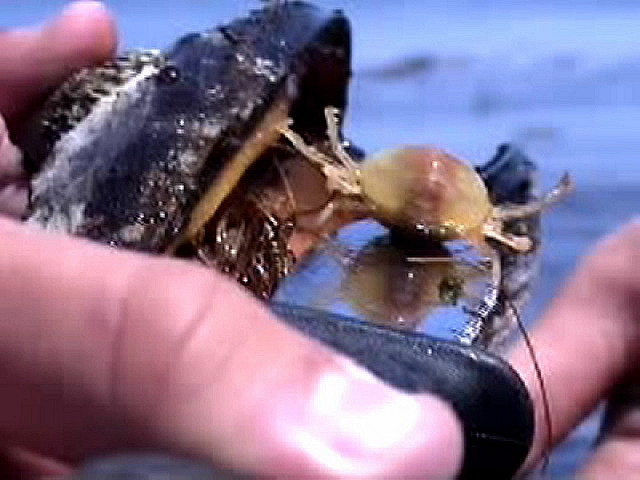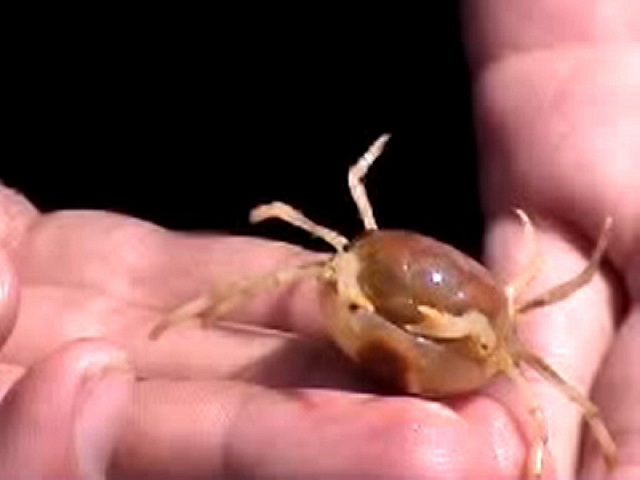Jeremias, Carmen and Felix remove a pea crab from the mantle of a California Mussel.
At Race Rocks there are many large mussels; (up to 30 cm) with such parasite inside.
Domain Eukarya
Kingdom Animalia
Phylum Arthropoda
Class Crustacea
Order Decapoda
Family Pinnotheridae
Genus Fabia
Species subquadrata
Common Name:Pea crab
Brief Definition
Pea/Mussel crabs are tiny creatures that live as symbionts, on or in the bodies of other invertebrates (bivalves)
Size
As their common name implies, Pea crabs are small creatures. The female pea crabs are distinctively larger than the male crabs, reachimg a size of 22mm (0.8in). The males however reach a size of 7.3mm (0.3in).
Habitat
Pea crabs occupy 2 different niches during their lifetime. Prior to and after their mating season, the adult female lives in a host. Host species include:
California mussels ( Mytilus californianus )
horse mussels ( Modiolus modiolus ).
Mytilus edulis
As well as other species of bivalves including scallops, oysters, cockles and clams.
The juvenile crabs also occupy a host before they become mature.
Range
These crabs live in mainly the northern hemisphere waters.
Including eastern and western U.S.(Akutan Pass, in the waters of Alaska to Ensenada.), Europe, Argentina and British Columbia, Canada.
It is found in 1 to 3% of California mussels along the central California coast, and 18% of mussels along Vancouver Island, BC, Canada.
Adaptation
Mussel crabs live in specific hosts because each crab responds positively to only certain chemicals that their hosts emit. In this way, they are able to infest the hosts that have the right conditions for them to survive. While in the host, these crabs do not posses an exokeleton. This is beacause the hosts provide them with protection against predators and other harmful external factors. However, when they leave their host to mate in the planktonic environment, the adult crabs grow an exoskeleton to protect their membranous carapace. These crabs also posses 10 legs, of which 2 of them develop into large and powerful claws to help fend off predators when exposed in the plankton, and to also help in the grasping of food.
Relationship with Host
The relationship that exists between the mussel crab and the bivalve is a symbiotic one. The advantage of this relationship is that the crab is protected while it scavenges the necessary nutrients needed by it, in the host. The crab however at times robs its host of a large mount of food and it also feeds off the protective mucus layers that cover the host’s tender tissues.This results in the mussel’s gills been injured. When this occurs the relationship becomes a parasitic one as the crab benefits while the host is affected negatively. Hence they are classified as parasites.
Precautions are taken when animals such as Mya arenaria, Placopecten magellanicus, Argopecten irradians and oysters are sold as to not have a pea crab inside it.
Reproduction and Lifecycle
The pea crabs’ life cycle has two distinct stages. These two stages are so different that in fact they were classified into two different genera.
The first stage comprises of the large, adult females that have soft membranous crapaces. These adults occupy a host each and they produce larvae that mature into the second stage. In the second stage, the offspring (larvae) of the female (that she had produced inside her host) grow up into adults of both sexes.Having reached maturity, they leave their hosts and join swarms in the water to mate. At this stage the pea crabs look more ‘traditional’. They have hard shells, strong legs (for swimming) and at the front of the carapace they have thick hair. Upon completion of mating, the female returns to her host. For a period of 21-25 weeks, she goes through 5 molts before reaching maturity. The female can inhabit here for up to a year, producing larvae from eggs that where fertilised by sperm from her single mating and then the cycle begins again. The mating takes place in late May.
Note: the male after mating dies.
References
Source 1: Pacific Coast Crabs and Shrimps by Gregory.C. Jensen, Ph.D
Source 2: Port Townsend Marine Science Center. Marine & Natural History Exihibits
Source 3: http://www.ptmsc.org/html/peacrabs.html
Source 4: http://life.bio.sunysb.edu/~jmatth/Science.htm
Source 5: http://www.pac.dfo-mpo.gc.ca/sci/shelldis/pages/pcbmu_e.htm
Source 6: http://www.indian-ocean.org/bioinformatics/crabs/crabs/tex1.html
| Other Members of the Phylum Arthropoda at Race Rocks |
and Image File |
 The Race Rocks taxonomy is a collaborative venture originally started with the Biology and Environmental Systems students of Lester Pearson College UWC. It now also has contributions added by Faculty, Staff, Volunteers and Observers on the remote control webcams. The Race Rocks taxonomy is a collaborative venture originally started with the Biology and Environmental Systems students of Lester Pearson College UWC. It now also has contributions added by Faculty, Staff, Volunteers and Observers on the remote control webcams.
October 2003- Michelle(PC) |


